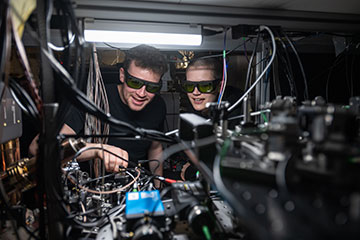
Dougal Main (left) and Beth Nichol working on the distributed quantum computer. [Image: John Cairns]
Quantum computers have the potential to revolutionize fields like cryptography and drug discovery, but scalability has been a lingering issue. Current devices are limited to hundreds or thousands of qubits—but to solve truly industry-disrupting problems, a quantum computer would likely need to have millions of qubits.
Now, researchers at the University of Oxford, UK, have demonstrated the first instance of distributed quantum computing, which represents a practical approach toward larger, more powerful machines (Nature, doi: 10.1038/s41586-024-08404-x). Instead of building one massive device, two smaller modules were photonically linked, allowing them to work together as if they were a single machine.
“Distributed quantum computing offers a clear pathway to scaling up quantum hardware,” said study author Dougal Main. “Regardless of how you actually build a quantum computer, we believe that the last step for scaling it up will likely always be a distributed architecture.”
Leveraging quantum teleportation
Scaling up the number of qubits in a quantum computer presents a significant technical challenge. Previously, researchers have simply built larger, more complex machines, which can be difficult to fabricate and maintain. Also, more qubits in a single device means a greater likelihood of errors due to uncontrolled interactions with the environment.
A distributed quantum computing architecture enables quantum computations to be executed by a network of quantum processing modules. In the current study, Main and his colleagues interconnected two ion-trap quantum processors with a fiber optic link. The modules were separated by about two meters, each containing a network qubit and a circuit qubit.
Scaling up the number of qubits in a quantum computer presents a significant technical challenge.
The photonic links enabled qubits in separate modules to be entangled, and the researchers were then able to leverage quantum gate teleportation to mediate deterministic two-qubit interactions between the circuit qubits.
“By carefully tailoring these interactions, we can perform logical quantum gates—the fundamental operations of quantum computing—between qubits housed in separate quantum computers,” Main said. “This breakthrough enables us to effectively ‘wire together’ distinct quantum processors into a single, fully connected quantum computer.”
The future of quantum computing
The design has several advantages over a single, monolithic device. For example, each smaller module is easier to build, replace and fine-tune without having to tweak an entire system. Also, even if a quantum computer with one million qubits is created, connecting two of them using the techniques described by Main and his colleagues could lead to a quantum computer with two million qubits.
“Given how quickly quantum technology is advancing—and the significant investments in the field—we believe that distributed quantum computing will soon move beyond being a proof of concept to become a core component of large-scale quantum systems,” Main says.

